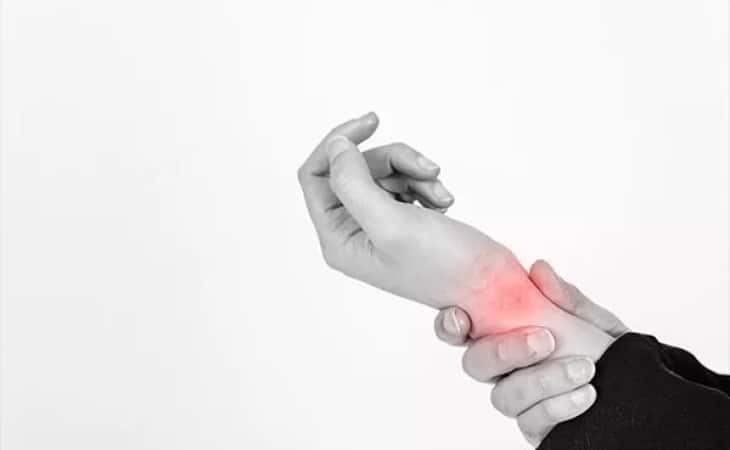
Hand pain and problems
Diagnosis
The hand is composed of many different bones, muscles, and ligaments that allow for a large amount of movement and dexterity. There are three major types of bones in the hand itself, including the following:
phalanges – the 14 bones that are found in the fingers of each hand and also in the toes of each foot. Each finger has three phalanges (the distal, middle, and proximal); the thumb only has two.
metacarpal bones – the five bones that compose the middle part of the hand
carpal bones – the eight bones that create the wrist. The carpal bones are connected to two bones of the arm, the ulnar bone and the radius bone
Numerous muscles, ligaments, and sheaths can be found within the hand. The muscles are the structures that can contract, allowing movement of the bones in the hand. The ligaments are fibrous tissues that help bind together the joints in the hand. The sheaths are tubular structures that surround part of the fingers.
What are some common hand problems?
There are many common hand problems that can interfere with activities of daily living (ADLs), including the following:
arthritis Arthritis is joint inflammation and commonly occurs at the base of the thumb. The pain associated with arthritis may be from many different sources, including inflammation of the following:
synovial membrane – a clear, sticky fluid that is released by the synovial membrane and acts as a lubricant for joints and tendons.
tendons – the tough cords of tissue that connect muscles to bones.
ligaments – a white, shiny, flexible band of fibrous tissue that binds joints together and connects various bones and cartilage.
Osteoarthritis, a degenerative joint disease, is the most common type of arthritis in older people. It is a slow-progressing disease that primarily affects the hands and the large weight-bearing joints of the body, such as the knees and hips. Osteoarthritis in the hands or hips may run in families, or be caused by injuries, overuse, muscle strain, or fatigue. Heberden nodes, abnormal enlargements of the bone or cartilage – about the size of a pea or smaller – may occur in the finger joints, and may be aggravated by osteoarthritis.
carpal tunnel syndrome
Carpal tunnel syndrome is a condition in which the median nerve is compressed as it passes through the carpal tunnel in the wrist, a narrow confined space. Since the median nerve provides sensory and motor functions to the thumb and three middle fingers, many symptoms may result.
The following are the most common symptoms for carpal tunnel syndrome However, each individual may experience symptoms differently. Symptoms may include:
difficulty making a fist
difficulty gripping objects with the hand(s)
pain and/or numbness in the hand(s)
“pins and needles” feeling in the fingers
swollen feeling in the fingers
burning or tingling in the fingers, especially the thumb and the index and middle fingers
The symptoms of carpal tunnel syndrome may resemble other conditions such as tendonitis, bursitis, or rheumatoid arthritis. Always consult your physician for a diagnosis.
Treatment may include:
splinting of the hand (to help prevent wrist movement and decrease the compression of the nerves inside the tunnel)
oral or injected (into the carpal tunnel space) anti-inflammatory medications (to reduce the swelling)
surgery (to relieve compression on the nerves in the carpal tunnel)
changing position of a computer keyboard, or other ergonomic changes
ganglion cysts
Soft, fluid-filled cysts can develop on the front or back of the hand for no apparent reason. These are called ganglion cysts – the most common, benign (non-cancerous), soft-tissue tumor of the hand and wrist.
The following are the most common symptoms for ganglion cysts. However, each individual may experience symptoms differently. Symptoms may include:
wrist pain that is aggravated with repeated use or irritation
a slow growing, localized swelling, with mild aching and weakness in the wrist
an apparent cyst that is smooth, firm, rounded, and/or tender
The symptoms of ganglion cysts may resemble other medical conditions or problems. Always consult your physician for a diagnosis. Initially, when the cyst is small and painless, treatment is usually not necessary. Only when the cyst begins to grow and interferes with the functionality of the hand is treatment usually necessary. Treatment may include:
rest
splinting
nonsteroidal anti-inflammatory medications
aspiration
cortisone injections
surgery
tendon problems
Two major problems associated with tendons include tendonitis and tenosynovitis. Tendonitis, inflammation of a tendon (the tough cords of tissue that connect muscles to bones) can affect any tendon, but is most commonly seen in the wrist and fingers. When the tendons become irritated, swelling, pain, and discomfort will occur.
Tenosynovitis is the inflammation of the lining of the tendon sheaths which enclose the tendons. The tendon sheath is usually the site which becomes inflamed, but both the sheath and the tendon can become inflamed simultaneously. The cause of tenosynovitis is often unknown, but usually strain, overuse, injury, or excessive exercise may be implicated. Tendonitis may also be related to disease (i.e., diabetes or rheumatoid arthritis).
Common tendon disorders include the following:
lateral epicondylitis (commonly known as tennis elbow) – a condition characterized by pain in the back side of the elbow and forearm, along the thumb side when the arm is alongside the body with the thumb turned away. The pain is caused by damage to the tendons that bend the wrist backward away from the palm
medial epicondylitis (commonly known as golfer’s or baseball elbow) – a condition characterized by pain from the elbow to the wrist on the palm side of the forearm. The pain is caused by damage to the tendons that bend the wrist toward the palm.
rotator cuff tendonitis -a shoulder disorder characterized by the inflammation of the shoulder capsule and related tendons.
DeQuervain’s tenosynovitis – the most common type of tenosynovitis disorder characterized by the tendon sheath swelling in the tendons of the thumb.
trigger finger/trigger thumb -a tenosynovitis condition in which the tendon sheath becomes inflamed and thickened, thus preventing the smooth extension or flexion of the finger/thumb. The finger/thumb may lock or “trigger” suddenly.
Treatment for most tendon problems may include:
activity modification
splinting or immobilization
steroid injections
anti-inflammatory medications
surgery
Quick Contacts
Please feel free to contact us for any medical inquiry
- Emergency call : +91 94274 18181
- Email : contact@trishahospital.com
- Location: Trisha multispeciality hospital, Ahmedabad



